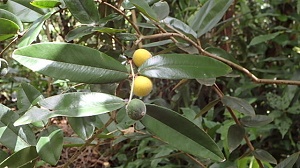| Cabelluda, Yellow Jaboticaba - Myrciaria glazioviana | |||
|---|---|---|---|
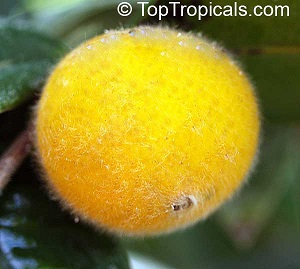 Fig. 1  Myrciaria glazioviana Yellow jaboticaba 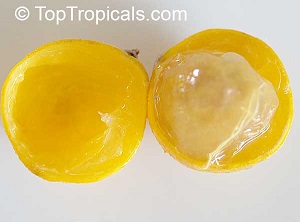 Fig. 2  Cross section 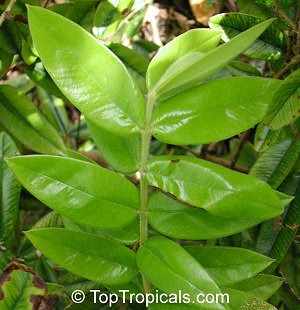 Fig. 3  Leaves 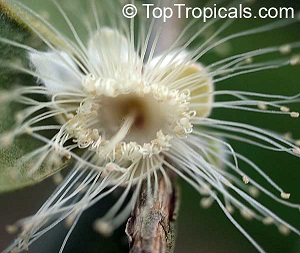 Fig. 4  Flower 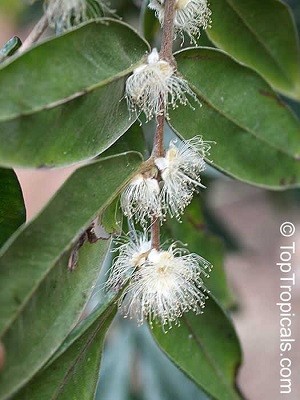 Fig. 5  Flower habit 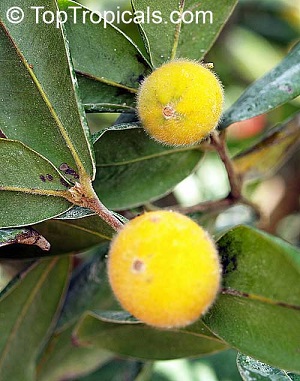 Fig. 6  Fruit and leaves 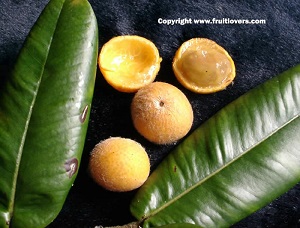 Fig. 8  Fruit and leaves 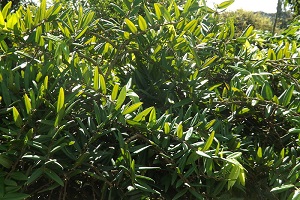 Fig. 9  Plinia glomerata foliage |
Scientific
name Myrciaria glazioviana (Kiaersk.) G.M.Barroso ex Sobral Common names Cabelluda, yellow jaboticaba; cabeludinha, cabeluda, peludinha in Brazil 3 Synonyms Eugenia cabelludo var. glazioviana Kiaersk; Paramyrciaria glazioviana (Kiaersk.) Sobral 4 Relatives Marlierea edulis (cambuca), Myrciaria cauliflora and M. jaboticaba (jaboticaba), M. dubia (camu camu) and M. vexator (blue grape) Family Myrtaceae Origin Probably native to Rio de Janeiro and Minas Gerais 3 USDA hardiness zones Tropical Uses Fruit Height 10-15 ft (3-4.6 m) Crown Dense crown Plant habit Large, evergreen shrub or small tree 3 Growth rate Slow growth Trunk/bark/branches Multiple trunks; branches almost touch the ground 3 Leaves Chartaceous; white tomentose on inferior surface; margins curved under; 2.5-4.5 in. (6.4-11.4 cm) 3 Flower Small, white, perfect and occur in axillary clusters Fruit Round; yellow; pubescent; 1 in. (2.5 cm); 1-2 seeds Season March-May in Puerto Rico Light requirement Full sun to partial shade Soil tolerances Moist but well drained, fertile, acid Drought tolerance Unknown Aerosol salt tolerance Unknown Soil salt tolerance Grows best in moist, fertile soils Cold tolerance Damage temp. 20 °F (-6.6 °C) Root system Shallow root system 5 Invasive potential * None reported Pest resistance Unknown Known hazard None For years, this plant has been erroneously identified with the names Eugenia tomentosa Cambess, and Eugenia glomerata O. berg. which identify other plants. 3 The following latin synonyms for Cabelluda: Eugenia cabelluda, E. tomentosa, Myrciaria glomerata, Paramyrciaria glomerata, Plinia glomerata - may be taxonomically incorrect, although in some sources excepted. Refer to pictures for better identification of this plant. Origin Native to Brazil The Cabelluda is scarcely known outside of Brazil. It has been introduced recently into the United States, where it should succeed in California and Florida. Description Cabelluda is a large shrub or small tree, 10-20 feet in height, with multiple thin trunks, very handsome and of value as an ornamental plant. The young stems and leaves are pubescent. Small white flowers are perfect and occur in axillary clusters. Fruiting occurs in 2-3 years, when the plant is hardly 3-4 feet tall. Cabelluda is rare in plant collections, however it is popular in cultivation around Rio de Janeiro, Brazil where its fruit ripen in October-November, in Puerto Rico March-May. 1 Fruit Fruits are about 1 inch in diameter, round, yellow when fully ripe, pubescent, with one or two seeds. Cabelluda fruits are delicious. They resemble large gooseberries in appearance and are sweet and aromatic, with a flavor similar to apricot. The fruits are very nutritive and rich in vitamins. 1
Fig. 7. Ripe fruit on the yellow Jaboticaba M. caufiflora. Unbelievable Acres Botanic Garden. Cold tolerance As a tropical tree, it is fairly cold tolerant and can withstand temperatures as low as upper 20's for a short period. Soft young leaves and twigs may get some cold damage, however even if severely damaged, in Spring the plant readily grows back from the roots. 1 Propagation Cabelluda is propagated by seed. Seeds have a short viability. They should be planted as soon after picking the fruit. The seed might sprout between 80-100 days. Fruiting occurs in 2-3 years, when the tree is as small as 3 feet tall. 1 Food Uses Cabelluda fruits are delicious fresh, and can also be used for juices and jams. Other Uses The wood is straight-grained, of average texture, moderately heavy, hard, slightly susceptible to wood eating organisms. Because of its small dimensions, it is only suitable for items such as agricultural tool handles The wood is used for fuel and to make charcoal. 6 List of Growers and Vendors |
||
| Bibliography 1 "Plinia glomerata, Myrciaria glazioviana, Eugenia cabelluda, Eugenia tomentosa, Myrciaria glomerata, Paramyrciaria glomerata." Top Tropicals nursery, toptropicals.com. Web. 30 Jan. 2015. 2 "Myrciaria glazioviana." Useful Tropical Plants Database, tropical.theterns.info. Web. 4 Apr. 2017. 3 Lorenzi, Harri, et al. Brazillian Fruits & Cultivated Exotics (for consuming in natura). Nova Odessa, Instituto Plantarum de Estudos da Flora, 2006. 4 "Myrciaria glazioviana (Kiaersk.) G.M.Barroso ex Sobral synonyms." The Plant List (2010). Version 1. theplantlist.org. Web. 4 apr. 2017. 5 The Encyclopedia of Fruit & Nuts, Edited by Jules Janick and Robert E. Paull, Cambridge, CABI, 2008. 6 Lorenzi, Harri. Brazilian Trees, A Guide to the Identification and Cultivation of Brazilian Native Trees, Vol. 3, Nova Odessa, Instituto Plantarum de Estudos da Flora, 2009. Photographs Fig. 1,2,3,4,5,6 Plinia glomerata, Myrciaria glazioviana, Eugenia cabelluda, Eugenia tomentosa, Myrciaria glomerata, Paramyrciaria glomerata. N.d. toptropicals.com. Web. 30 Jan. 2015. Fig. 7 Sample, Jane. Ripe fruit on the yellow Jaboticaba Myrciara caufiflora. Unbelievable Acres Botanic Garden. 2015. flickr.com. Web. 4 Apr. 2017. Fig. 8 Jaitt, Oscar. Yellow Jaboticaba or Cabelluda. N.d. fruitlovers.com. Web 30 Jan. 2015. Fig. 9 Rodrigues de Andrade, Juan Júnio. Plinia glomerata. 2013. commons.wikimedia.org. Public domain. Web. 4 Apr. 2017. * UF/IFAS Assessment of Non-native Plants in Florida's Natural Areas Published 30 Jan. 2015 LR. Last update 10 Feb. 2019 LR |
|||
